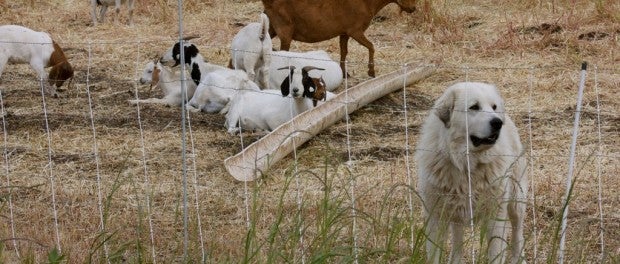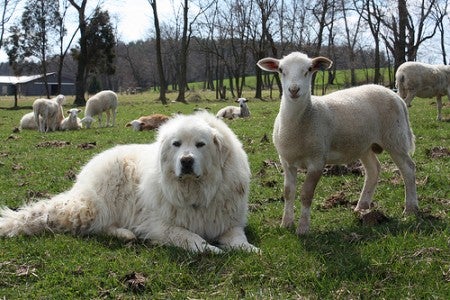The Always Vigilant Livestock Guardian Dog

Regardless of the types of livestock that call your farm home, those animals all have one thing in common: vulnerability to predation. The type of livestock you raise in comparison with the predators in your area can make a difference in this vulnerability, but on some level the risk is always there. As farmers, we all know how dismaying and financially difficult the loss of one or more livestock animals can be, so it is important to protect the animals that live and are raised on our farms. One way to do this is with a Livestock Guardian Dog, or LGD.
Livestock Guardian Dogs are some of the best animals you can put on the payroll when it comes to keeping your farm animals safe. These animals have been bred for generations to achieve the most effective dogs possible, resulting in a combination of traits necessary to get the job done. LGDs are very focused on the herds they are entrusted to protect, bonding with them and ensuring their safety through vigilance, especially at night. They are hardy and handle life outdoors without problem, living in the pasture with those they protect.
The temperament of a Livestock Guardian Dog can be confusing to people who are used to dogs as pets, however. The LGD is not a cuddly lap dog by any stretch of the imagination. Instead they are an aloof watchman, preferring the company of the herd to human contact. They are not recommended as a child’s pet and likely will not adapt to being one. Though they get along with people, it is more of a co-existence than an actual bond due to the alpha nature of the dog and how in tune they are to their job as stock guardians. It is this very same nature that requires socialization, however, so that such dogs are respectful and manageable.
As puppies, LGDs should be introduced to other animals on the farm. This includes not only the stock that they will be guarding but also other dogs and similar animals with which they are expected to get along. Since other dogs can be perceived as threats to the flock, a careful introduction is necessary so the LGD will accept other dogs. This includes other LGDs as well. Although having more than one LGD is good as the effectiveness of a working pair is better than a single dog, it is still vital that they be properly and safely introduced, or ideally raised together as puppies. It should be expected for them to take a full year and a half to mature and assume their guardian duties. Pairs should be altered so they cannot reproduce and ideally of the opposite sex as failure to alter dogs can result in fights amongst dogs.
When seeking a LGD, there are many breeds to consider. These include the Akbash, Anatolian Shepherd, Great Pyrenees, Karst, Komandor, Kuvasz, Maremma, Ovtcharka, and Tatra. The basic nature of these dogs will be the same with variations amongst appearance and intelligence. It is important to choose the best dog for your climate so they are less likely to become overheated in the warm months or get too cold during harsh winters as these animals will bed down with the flock or herd they protect.
There are some behaviors of the LGD which must be understood by owners before bringing one home. One of those is that the dog will consume stillborn babies or dead animals. Upon seeing this, it is easy to assign blame to the LGD for the death of that animal, but the reality is that a dead animal attracts predators and consuming it is just another way in which the LGD protects the remainder of the herd. It will also take action against animals that are injured or dying by either pushing that animal back into the herd or separating it from the herd, based on the condition of that animal and what is best for the others. Should you see behaviors such as this on the part of a LGD, it is important to look at the big picture before deciding that your dog is doing something wrong. Chances are your dog is merely doing the job as instinct is telling it to do.
Although it shouldn’t surprise you to see a LGD kill and eat a squirrel, that does not mean you need not fill their food bowl. LGDs should be fed regularly of a healthy diet. Additionally, since they live outdoors and are responsible for thwarting predation, it is a requirement that they stay up to date on a full line of annual vaccinations, especially rabies as the chances they could come into contact with such diseases is heightened by the contact they may make with carriers. Flea and tick prevention is necessary as well.
Though they may not always be visible, the Livestock Guardian Dog is always vigilant. He watches over his herd, sometimes from a distance, ensuring their safety at all times of day but especially at night when predators lurk. While it is possible to bond with your LGDs, don’t be offended if they prefer the company of the herd to that of you. This simply means your LGD is doing as he should, punching the time clock to do his job on the farm.






 Your Privacy Choices
Your Privacy Choices
We’ve seen LGDs eat dead lambs before (lots of other critters too) and I agree it’s just them doing their job.